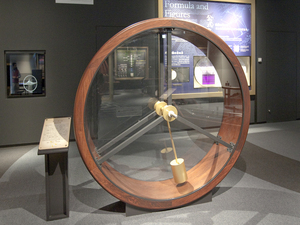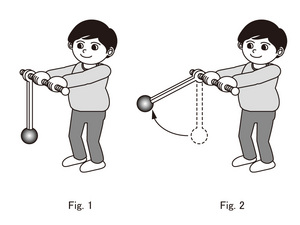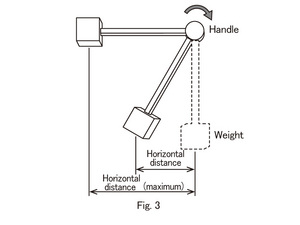Nagoya City Science Museum
TOP > Exhibition Guide > Keyword Search > Starting with "M" > motion > Moment
Moment



Purpose of Exhibition
When rotating the handle, a larger force is necessary to hold the handle, but not because the weight of the weight has change.
You will physically experience the notion of 'moment' around the rotating axis.
Additional Knowledge
This is an exhibition in which you rotate the handle and lift a weight.
As in Figure 1, you take hold of the handle; you lift the weight directly connected to the handle by rotating the handle.
Please note that the weight position in figure 2 gets higher and the force required to rotate the handle becomes higher.
Why doe the force applied upon the handle get larger, but the weight doesn't change?
[Differences in horizontal distance]
Even if you rotate the handle, the weight of the weight has not changed, and the distances from the handle to the weight have not changed, either. So, what has changed? The force required for the handle?As in figure 3, we will consider the horizontal distance.
To what extent the handle and the weight are deviated is the called horizontal distance. When the weight is just below the handle, the two horizontal distances are zero.
When the weight is lifted to the same height as the handle, the horizontal distance is the greatest, similarly to the length between the weight and the handle. That is, the higher the position of the weight, the longer the horizontal distance from the weight to the handle becomes. Thereby, the force applied to the handle is getting larger. The force applied to the handle is proportional to the horizontal distance.
[Moment of force]
The force applied to the handle is considered to be the weight of the weight multiplied by the horizontal distance.
This is called "Moment of force" in physics terms.
In particular, the moment of force around the axis of rotation is called "torque". It is used to represent by number, the performances of powerful machines such as automobiles, engines or motors. "Torque" is multiplied by number of rotations.
[Moment around]
When lifting the weight to a higher place in the exhibit, a larger force to keep the weight from falling and the handle fixed is required.
If we think about it in reverse, by having a larger horizontal distance, you can apply a large force to the axe of rotation.
The tools used to tighten bolts and nuts are spanners and wrenches.
By using a long-armed one, the nuts could be more strongly tightened. However, because of problems such as broken bolts being tightened too tightly, a small spanner's arm for small nuts is better.
In short, the lengths of spanner-arms and wrench-arms are designed to apply force properly.
Article by Yoshitaka Yamada, curator
